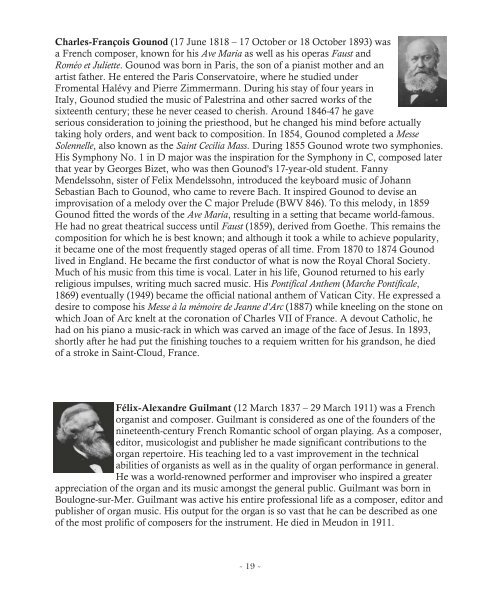French Mass - The Cathedral of St. John the Evangelist
French Mass - The Cathedral of St. John the Evangelist
French Mass - The Cathedral of St. John the Evangelist
You also want an ePaper? Increase the reach of your titles
YUMPU automatically turns print PDFs into web optimized ePapers that Google loves.
Charles-François Gounod (17 June 1818 – 17 October or 18 October 1893) was<br />
a <strong>French</strong> composer, known for his Ave Maria as well as his operas Faust and<br />
Roméo et Juliette. Gounod was born in Paris, <strong>the</strong> son <strong>of</strong> a pianist mo<strong>the</strong>r and an<br />
artist fa<strong>the</strong>r. He entered <strong>the</strong> Paris Conservatoire, where he studied under<br />
Fromental Halévy and Pierre Zimmermann. During his stay <strong>of</strong> four years in<br />
Italy, Gounod studied <strong>the</strong> music <strong>of</strong> Palestrina and o<strong>the</strong>r sacred works <strong>of</strong> <strong>the</strong><br />
sixteenth century; <strong>the</strong>se he never ceased to cherish. Around 1846-47 he gave<br />
serious consideration to joining <strong>the</strong> priesthood, but he changed his mind before actually<br />
taking holy orders, and went back to composition. In 1854, Gounod completed a Messe<br />
Solennelle, also known as <strong>the</strong> Saint Cecilia <strong>Mass</strong>. During 1855 Gounod wrote two symphonies.<br />
His Symphony No. 1 in D major was <strong>the</strong> inspiration for <strong>the</strong> Symphony in C, composed later<br />
that year by Georges Bizet, who was <strong>the</strong>n Gounod's 17-year-old student. Fanny<br />
Mendelssohn, sister <strong>of</strong> Felix Mendelssohn, introduced <strong>the</strong> keyboard music <strong>of</strong> Johann<br />
Sebastian Bach to Gounod, who came to revere Bach. It inspired Gounod to devise an<br />
improvisation <strong>of</strong> a melody over <strong>the</strong> C major Prelude (BWV 846). To this melody, in 1859<br />
Gounod fitted <strong>the</strong> words <strong>of</strong> <strong>the</strong> Ave Maria, resulting in a setting that became world-famous.<br />
He had no great <strong>the</strong>atrical success until Faust (1859), derived from Goe<strong>the</strong>. This remains <strong>the</strong><br />
composition for which he is best known; and although it took a while to achieve popularity,<br />
it became one <strong>of</strong> <strong>the</strong> most frequently staged operas <strong>of</strong> all time. From 1870 to 1874 Gounod<br />
lived in England. He became <strong>the</strong> first conductor <strong>of</strong> what is now <strong>the</strong> Royal Choral Society.<br />
Much <strong>of</strong> his music from this time is vocal. Later in his life, Gounod returned to his early<br />
religious impulses, writing much sacred music. His Pontifical An<strong>the</strong>m (Marche Pontificale,<br />
1869) eventually (1949) became <strong>the</strong> <strong>of</strong>ficial national an<strong>the</strong>m <strong>of</strong> Vatican City. He expressed a<br />
desire to compose his Messe à la mémoire de Jeanne d'Arc (1887) while kneeling on <strong>the</strong> stone on<br />
which Joan <strong>of</strong> Arc knelt at <strong>the</strong> coronation <strong>of</strong> Charles VII <strong>of</strong> France. A devout Catholic, he<br />
had on his piano a music-rack in which was carved an image <strong>of</strong> <strong>the</strong> face <strong>of</strong> Jesus. In 1893,<br />
shortly after he had put <strong>the</strong> finishing touches to a requiem written for his grandson, he died<br />
<strong>of</strong> a stroke in Saint-Cloud, France.<br />
Félix-Alexandre Guilmant (12 March 1837 – 29 March 1911) was a <strong>French</strong><br />
organist and composer. Guilmant is considered as one <strong>of</strong> <strong>the</strong> founders <strong>of</strong> <strong>the</strong><br />
nineteenth-century <strong>French</strong> Romantic school <strong>of</strong> organ playing. As a composer,<br />
editor, musicologist and publisher he made significant contributions to <strong>the</strong><br />
organ repertoire. His teaching led to a vast improvement in <strong>the</strong> technical<br />
abilities <strong>of</strong> organists as well as in <strong>the</strong> quality <strong>of</strong> organ performance in general.<br />
He was a world-renowned performer and improviser who inspired a greater<br />
appreciation <strong>of</strong> <strong>the</strong> organ and its music amongst <strong>the</strong> general public. Guilmant was born in<br />
Boulogne-sur-Mer. Guilmant was active his entire pr<strong>of</strong>essional life as a composer, editor and<br />
publisher <strong>of</strong> organ music. His output for <strong>the</strong> organ is so vast that he can be described as one<br />
<strong>of</strong> <strong>the</strong> most prolific <strong>of</strong> composers for <strong>the</strong> instrument. He died in Meudon in 1911.<br />
- 19 -





